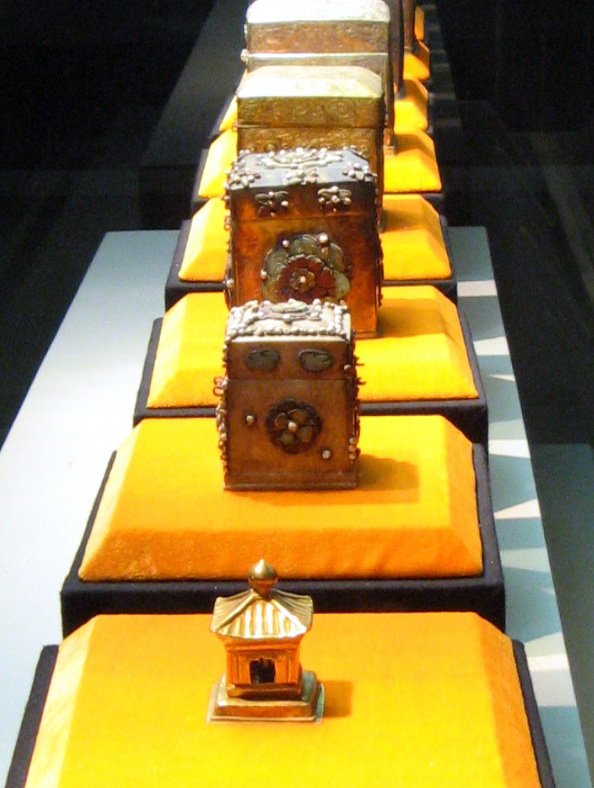Chinese boxes on:
[Wikipedia]
[Google]
[Amazon]
 Chinese boxes () are a set of
Chinese boxes () are a set of
 Chinese boxes () are a set of
Chinese boxes () are a set of box
A box (plural: boxes) is a container with rigid sides used for the storage or transportation of its contents. Most boxes have flat, parallel, rectangular sides (typically rectangular prisms). Boxes can be very small (like a matchbox) or v ...
es of graduated size, each fitting inside the next larger box.
A traditional style in Chinese design, nested boxes have proved a popular packaging option in the West for novelty or display reasons.
Chinese nested boxes have inspired similar forms of packaging around the world, but also have found use as a figurative description, providing an illustrative example to demonstrate situations of conceptually nested or recursive arrangements.
In literature, a Chinese box structure refers to a frame narrative, where a novel or drama is told in the form of a narrative inside a narrative (and so on), giving views from different perspectives. Examples include Plato
Plato ( ; Greek language, Greek: , ; born BC, died 348/347 BC) was an ancient Greek philosopher of the Classical Greece, Classical period who is considered a foundational thinker in Western philosophy and an innovator of the writte ...
's dialogue ''Symposium
In Ancient Greece, the symposium (, ''sympósion'', from συμπίνειν, ''sympínein'', 'to drink together') was the part of a banquet that took place after the meal, when drinking for pleasure was accompanied by music, dancing, recitals, o ...
'', Mary Shelley
Mary Wollstonecraft Shelley ( , ; ; 30 August 1797 – 1 February 1851) was an English novelist who wrote the Gothic novel ''Frankenstein, Frankenstein; or, The Modern Prometheus'' (1818), which is considered an History of science fiction# ...
's 1818 novel ''Frankenstein
''Frankenstein; or, The Modern Prometheus'' is an 1818 Gothic novel written by English author Mary Shelley. ''Frankenstein'' tells the story of Victor Frankenstein, a young scientist who creates a Sapience, sapient Frankenstein's monster, crea ...
'', Jostein Gaarder's '' The Solitaire Mystery'', Emily Brontë
Emily Jane Brontë (, commonly ; 30 July 1818 – 19 December 1848) was an English writer best known for her 1847 novel, ''Wuthering Heights''. She also co-authored a book of poetry with her sisters Charlotte Brontë, Charlotte and Anne Bront� ...
's ''Wuthering Heights
''Wuthering Heights'' is the only novel by the English author Emily Brontë, initially published in 1847 under her pen name "Ellis Bell". It concerns two families of the landed gentry living on the West Yorkshire moors, the Earnshaws and the ...
'', and Joseph Conrad
Joseph Conrad (born Józef Teodor Konrad Korzeniowski, ; 3 December 1857 – 3 August 1924) was a Poles in the United Kingdom#19th century, Polish-British novelist and story writer. He is regarded as one of the greatest writers in the Eng ...
's ''Heart of Darkness
''Heart of Darkness'' is an 1899 novella by Polish-British novelist Joseph Conrad in which the sailor Charles Marlow tells his listeners the story of his assignment as steamer captain for a Belgium, Belgian company in the African interior. Th ...
''.
See also
*Recursion
Recursion occurs when the definition of a concept or process depends on a simpler or previous version of itself. Recursion is used in a variety of disciplines ranging from linguistics to logic. The most common application of recursion is in m ...
*Mise en abyme
In Western art history, ''mise en abyme'' (; also ''mise en abîme'') is the technique of placing a copy of an image within itself, often in a way that suggests an infinitely recurring sequence. In film theory and literary theory, it refers to t ...
*Matryoshka doll
Matryoshka dolls (), also known as stacking dolls, nesting dolls, Russian tea dolls, or Russian dolls, are a set of wooden dolls of decreasing size placed one inside another. The name ''Matryoshka'' is a diminutive form of ''Matryosha'' (), i ...
*Infinity
Infinity is something which is boundless, endless, or larger than any natural number. It is denoted by \infty, called the infinity symbol.
From the time of the Ancient Greek mathematics, ancient Greeks, the Infinity (philosophy), philosophic ...
References
External links
Containers Chinese inventions Nested containers {{design-stub